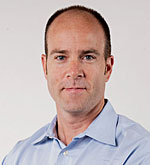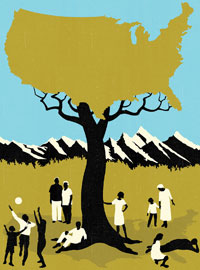sierraclub.org - sierra magazine - nov/dec 2012 - your land, my land
YOUR LAND, MY LAND
Making sure protected public lands stay that way
By Michael Brune
 Michael Brune, Sierra Club executive director | Photo by Lori Eanes
Michael Brune, Sierra Club executive director | Photo by Lori Eanes
The Great American Novel may remain unwritten, but the Great American Song was nailed when Woody Guthrie wrote "This Land Is Your Land." No one before or since has summed up our nation's outdoor ethic better or more simply: "This land was made for you and me."
In addition to the lines about the redwood forest and diamond deserts, Guthrie's song has a grittier verse that you probably didn't sing in grade school:
As I went walking I saw a sign there
And on the sign it said "No Trespassing."
But on the other side it didn't say nothing,
That side was made for you and me.
Hostility to conservation flies in the face of concerns about the economy.
Our public lands, the side of America that truly belongs to you and me, are a source of both tremendous pride and sacred responsibility. We're talking about a lot of golden valleys and more: some 600 million acres, mostly west of the Mississippi and in Alaska. Many of these acres—like those in our 58 national parks and 75 national monuments—are officially protected from development and commercial exploitation.
 Illustration by Neil Webb
Illustration by Neil Webb
That doesn't mean, however, that we can assume they're going to stay safe. The Grand Canyon, for instance, one of our iconic national parks, is threatened by uranium mining that could contaminate the Arizona park's 10-million-acre watershed with radioactive pollution. And Utah's Bryce Canyon, celebrated for having one of the darkest night skies in the continental United States, could lose that distinction if Alton Coal Development is allowed to quintuple the size of a nearby strip mine on public lands.
The relentless urge to dig, drill, and despoil poses an even graver threat to precious public lands that have yet to be protected—places like Utah's Greater Canyonlands or New Mexico's Otero Mesa. Many of these areas have strong local support for protection. Unfortunately, the current Republican majority in the House has refused to act on any major public lands bills. Instead, the House leadership has been working to roll back environmental safeguards for our nation's land, water, and wildlife.
Ironically, this hostility to conservation flies in the face of concerns about the economy. Protecting public lands, it turns out, has well-documented economic benefits. According to a study by the Outdoor Industry Association, 140 million Americans engaged in outdoor activities in 2011. The $646 billion they spent supported more than 6 million jobs. Independent research group Headwaters Economics studied 17 national monuments and found that in every case, local economies, employment, and per capita income all increased after nearby public lands received protection.
Economics aside, failing to protect deserving public lands is at odds with a value Americans have shared for the last century—that our beautiful natural areas should be preserved for their own sakes. Most Americans will never make it up to Alaska's Arctic National Wildlife Refuge, but it's still important to keep it intact, not scarred by drilling rigs and haul roads.
Since 1892, the Sierra Club has worked to protect public lands and—just as important—to make sure that once something has been protected, it stays that way. You can help. With the Club's new My Piece of America campaign, you can share information about your favorite special places and connect with local campaigns to protect them.
Check it out. Keep places like the Grand Canyon and Bryce Canyon protected while encouraging the president to continue designating national monuments and to hold the line against those who would sacrifice America's national treasures for the sake of corporate profits.
Together, we can be sure these lands will always be there. Not just for you and me—but for generations to come.
Michael Brune is the executive director of the Sierra Club. You can e-mail him at michael.brune@sierraclub.org and follow him on Twitter and Facebook.